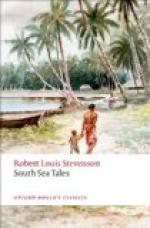A good way to appreciate the depopulation is to go by land from Anaho to Hatiheu on the adjacent bay. The road is good travelling, but cruelly steep. We seemed scarce to have passed the deserted house which stands highest in Anaho before we were looking dizzily down upon its roof; the Casco well out in the bay, and rolling for a wager, shrank visibly; and presently through the gap of Tari’s isthmus, Ua-huna was seen to hang cloudlike on the horizon. Over the summit, where the wind blew really chill, and whistled in the reed-like grass, and tossed the grassy fell of the pandanus, we stepped suddenly, as through a door, into the next vale and bay of Hatiheu. A bowl of mountains encloses it upon three sides. On the fourth this rampart has been bombarded into ruins, runs down to seaward in imminent and shattered crags, and presents the one practicable breach of the blue bay. The interior of this vessel is crowded with lovely and valuable trees,—orange, breadfruit, mummy-apple, cocoa, the island chestnut, and for weeds, the pine and the banana. Four perennial streams water and keep it green; and along the dell, first of one, then of another, of these, the road, for a considerable distance, descends into this fortunate valley. The song of the waters and the familiar disarray of boulders gave us a strong sense of home, which the exotic foliage, the daft-like growth of the pandanus, the buttressed trunk of the banyan, the black pigs galloping in the bush, and the architecture of the native houses dissipated ere it could be enjoyed.
The houses on the Hatiheu side begin high up; higher yet, the more melancholy spectacle of empty paepaes. When a native habitation is deserted, the superstructure—pandanus thatch, wattle, unstable tropical timber—speedily rots, and is speedily scattered by the wind. Only the stones of the terrace endure; nor can any ruin, cairn, or standing stone, or vitrified fort present a more stern appearance of antiquity. We must have passed from six to eight of these now houseless platforms. On the main road of the island, where it crosses the valley of Taipi, Mr. Osbourne tells me they are to be reckoned by the dozen; and as the roads have been made long posterior to their erection, perhaps to their desertion, and must simply be regarded as lines drawn at random through the bush, the forest on either hand must be equally filled with these survivals: the gravestones of whole families. Such ruins are tapu in the




